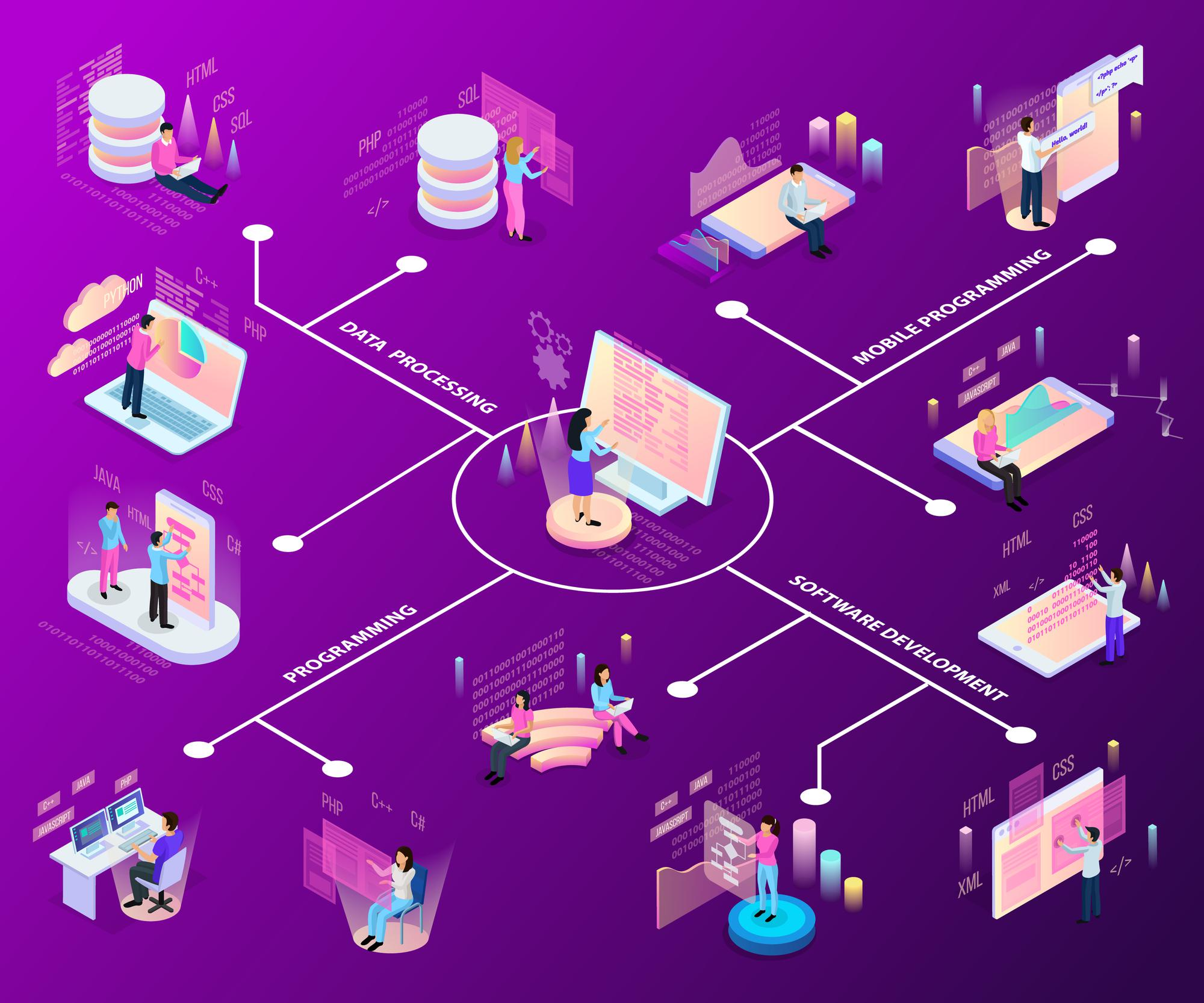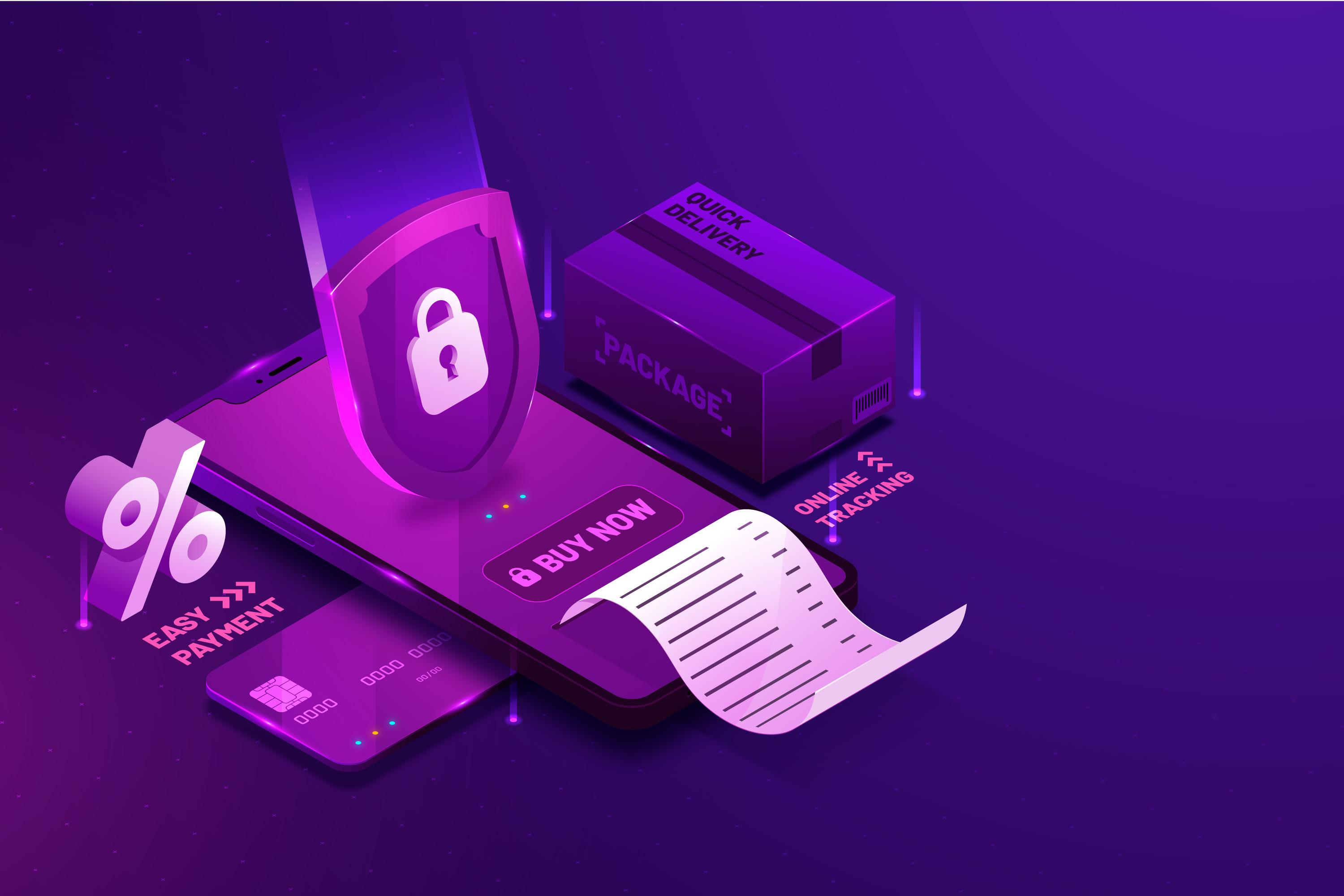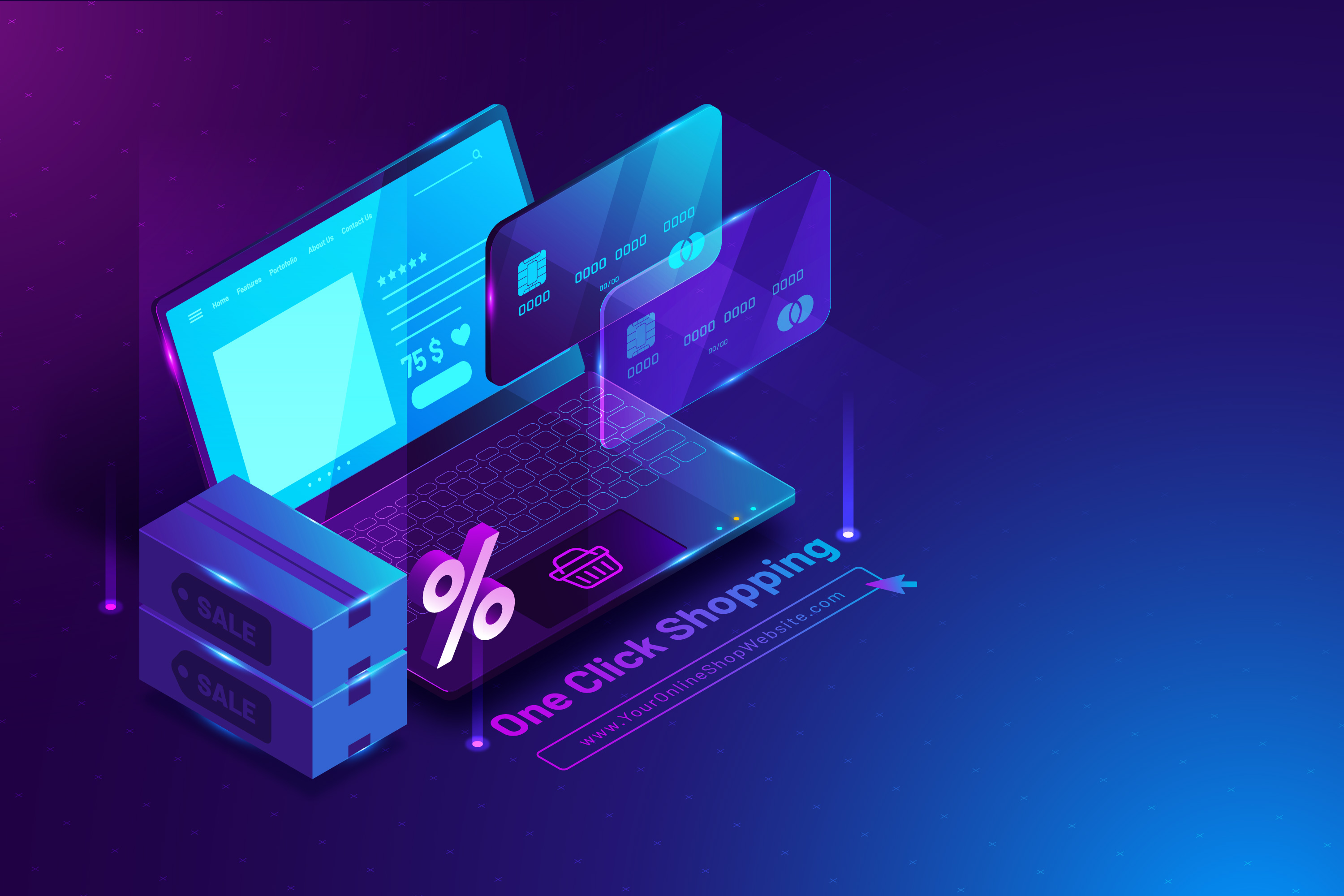The FinTech revolution is transforming the financial landscape. The way we manage our money is undergoing a revolution fueled by innovative solutions like mobile banking apps, secure payment systems, and data-driven financial tools. However, to turn your brilliant FinTech idea into reality, you’ll need a skilled and reliable banking software development partner by your side.
This guide empowers you to navigate the selection process with confidence. We’ll equip you with a comprehensive checklist to evaluate potential partners based on their expertise, cultural fit, and alignment with your specific project requirements. By following these steps, you can ensure you choose the software development company that propels your FinTech venture towards success.
The Evolving Banking Landscape Powered by FinTech Innovation

Source: Freepik
The financial technology (FinTech) revolution is reshaping banking operations, driven by advancements in banking software development companies and core financial software solutions. Financial institutions (FIs) are embracing digital transformation to meet customer expectations for convenience, speed, and a seamless user experience.
Banking Software Services Fueling the Transformation:
- Digital Banking Proliferation: Banking software development underpins the rise of digital banking, enabling features like 24/7 mobile banking through user-friendly apps, streamlined online account opening, and personalized financial management tools.
- FinTech Innovation: FinTech startups are disrupting the traditional banking sector with innovative solutions like alternative lending platforms, mobile payment solutions, and blockchain technology for secure and transparent financial transactions.
- Emerging Tech Integration: Banking software development serves as a platform for integrating cutting-edge technologies like Artificial Intelligence (AI) for enhanced security, fraud detection, and personalized recommendations. Big Data Analytics empowers FIs to develop targeted marketing campaigns and products, while Cloud Computing offers scalability and cost-effectiveness for managing vast amounts of financial data.
Navigating the Evolving Landscape:
- Regulatory Compliance: Banking software development must adhere to evolving regulations concerning data privacy (GDPR, CCPA), cybersecurity, and anti-money laundering (AML) practices. Regulatory compliance solutions ensure adherence to these frameworks.
- Open Banking: The future holds immense potential with advancements in Open Banking, fostering collaboration between FIs and third-party providers to create innovative financial solutions.
Building a Competitive Advantage:
- Custom Software Development: Financial software companies can leverage custom software development to create unique core banking systems tailored to specific needs. This allows FIs to differentiate themselves in the market.
- Tech Expertise: Staying ahead of the curve requires partnering with fintech software development companies with extensive experience and technology expertise in areas like machine learning and cloud migrations.
Enhancing Customer Experience:
- User-Friendly Interfaces: FinTech development prioritizes user-friendly interfaces (UI/UX) across various platforms, including mobile devices, to ensure customer satisfaction and retention. Features like personalized recommendations further enhance the user experience.
Security and Stability:
- Data Security: FinTech software development prioritizes data security to prevent data breaches. Secure development practices, combined with expert developers, are crucial in this regard.
- Process Automation: Financial services companies can leverage automation to streamline operations, improve efficiency, and reduce costs.
The banking landscape is constantly evolving, and partnering with a trusted FinTech software development company is vital for FIs to stay competitive. By leveraging cutting-edge technologies, financial software companies can help banks transform their operations, streamline processes, and deliver innovative financial solutions to their customers.
II. Unveiling the Banking Software Development Process

Source: Freepik
Transforming your vision for innovative banking software into a reality requires a well-defined development process. This section unveils the key stages involved in bringing your ideas to life:
1. Requirement Gathering and Project Planning:
- Defining Project Goals: Clearly outline the objectives and functionalities your software aims to achieve. This initial step involves collaboration with your chosen development partner to ensure alignment between your vision and technical feasibility.
- Identifying User Needs: Conduct thorough user research to understand target audience needs, pain points, and desired functionalities. Business analysts from your development agency can often play a crucial role in facilitating this research.
- Creating a Project Roadmap: Develop a roadmap that outlines key milestones, timelines, resource allocation, and the development methodology best suited to your project (e.g., Agile vs. Waterfall). This roadmap serves as a blueprint for the entire development journey.
2. Choosing a Development Methodology:
Your chosen banking software development partner should offer expertise in various methodologies to best suit your project needs. Here’s a breakdown of two common approaches:
- Agile Development: This iterative approach emphasizes collaboration, flexibility, and rapid delivery of features in short cycles. It’s ideal for projects with evolving requirements where continuous feedback loops are essential.
- Waterfall Development: This traditional approach follows a linear sequence of development phases, requiring detailed upfront planning. It may be suitable for projects with well-defined requirements and a stable feature set.
3. Design and Development:
- User Interface (UI) and User Experience (UX) Design: The development agency’s UI/UX design team will craft a user-friendly interface that is intuitive, visually appealing, and caters to a seamless user experience. This includes designing for various platforms your software might target (web, mobile).
- Software Development: Skilled developers, leveraging a modern tech stack and secure coding practices, will translate designs into functional code. Your partner should have a proven track record in areas like risk management, data security, and core banking system integration (if applicable).
4. Testing and Quality Assurance:
- Rigorous Testing Procedures: Your partner should implement comprehensive testing strategies throughout development to identify and rectify bugs, ensuring software stability and functionality. This might involve partnering with external testing specialists.
- Security Testing: Prioritize security testing throughout the development lifecycle to safeguard sensitive financial data. Your partner should demonstrate expertise in areas like fraud prevention and identity verification.
5. Deployment and Maintenance:
- Software Deployment: Launch the software on chosen platforms (web, mobile) and ensure a smooth rollout process, often involving project managers from both sides.
- Ongoing Maintenance and Support: Your partner should provide ongoing support and maintenance services to address bugs, implement updates, and maintain software performance. This ensures your FinTech solution stays secure, reliable, and adapts to evolving needs.
The specific details of each stage may vary depending on the chosen development methodology and project complexity. However, understanding these core steps provides a roadmap for navigating the exciting journey of banking software development.
III. Choosing Your Path: Custom vs. Pre-Built Core Banking Systems

Developing banking software requires a strategic decision: tailoring a custom solution or leveraging a pre-built option. Both approaches offer distinct advantages, and the optimal choice hinges on your specific needs and priorities. Let’s delve into each approach:
Custom Banking Software Development Services: Tailoring Solutions for Success
Custom banking software development offers unparalleled flexibility and control. You can build banking software that perfectly aligns with your unique business goals, functionalities, and brand identity. Here are some key benefits:
- Highly Scalable and Customizable: The custom software solutions can adapt and grow alongside your business, accommodating future needs and integrations.
- Enhanced Security and Compliance: Custom development allows for robust security measures and ensures adherence to specific regulatory requirements.
- Integration with Existing Systems: Seamless integration with your existing legacy systems can be achieved for a smooth workflow.
However, custom software development also comes with considerations:
- Time and Cost Investment: The development process can be time-consuming and require a significant initial investment.
- In-House Expertise or Partner Selection: You may need to build an internal development team or carefully choose a development partner with the necessary expertise.
Pre-Built Banking Software Solutions: A Faster Path to Market
Pre-built banking solutions offer a quicker and more cost-effective entry point. These off-the-shelf solutions come with pre-defined features that can address core banking functionalities. Here are some advantages:
- Rapid Deployment: Pre-built solutions can be implemented much faster than custom development, allowing you to launch your software sooner.
- Reduced Cost: The initial investment is typically lower compared to custom development.
- Vendor Support: Many vendors offer ongoing support and maintenance services.
However, pre-built solutions also have limitations:
- Limited Customization: The software may not cater to all your specific needs and functionalities, potentially requiring workarounds or integrations.
- Potential Vendor Lock-in: Switching to a different solution in the future may be complex and costly.
- Security Considerations: While security is important for pre-built solutions as well, you may have less control over specific security features.
Choosing the Right Path
The optimal choice depends on your specific requirements. Here are some guiding factors:
- Project Budget and Timeline: If time-to-market is crucial and budget is a constraint, a pre-built solution might be preferable.
- Uniqueness of Requirements: Highly specialized needs or complex integrations may necessitate custom development.
- Scalability Needs: If you anticipate significant future growth, the scalability of a custom solution might be advantageous.
By carefully considering these factors and your unique situation, you can make an informed decision that propels your banking software development journey towards success.
IV. Selecting the Right Banking Software Development Company

Your FinTech vision hinges on a strong foundation – the right banking software development partner. This section empowers you to make informed decisions by outlining a framework for evaluating potential development agencies.
Understanding Your Unique Needs
The first step is a thorough self-assessment. Clearly define your project goals and functionalities. Who is your target audience? What specific pain points will your software address?
Crystallize Your Project Goals and Requirements
The foundation for a successful partnership lies in a clear understanding of your project’s goals and requirements. Here’s how to approach this:
- Define Project Objectives: Articulate the specific functionalities and outcomes you aim to achieve with your banking software.
- Identify Target Users and Needs: Clearly define your target audience and their specific needs. Understanding user pain points and desired functionalities is essential.
- Outline Technical Requirements: Develop a comprehensive list of technical specifications, including integrations, security protocols, and scalability considerations.
Partner Evaluation: Expertise, Reputation, and Cultural Fit
With your project requirements defined, you can effectively assess potential development partners. Here are key considerations:
- Researching Company Expertise: Investigate the experience and proven track record of potential partners. Look for a banking software development company with a strong reputation in the banking software development space. Focus on companies that have successfully delivered projects for clients with similar needs and functionalities to yours. Industry awards and recognition from reputable organizations can be indicators of a company’s expertise. Consider utilizing resources that analyze and compare the capabilities of various banking software development companies.
- Evaluating Development Methodologies: Inquire about the development methodologies employed by potential partners (e.g., Agile, Waterfall). Understanding their approach ensures alignment with your project timeline and preferences.
- Assessing Cultural Fit and Communication Style: Effective communication and a collaborative working style are essential. Schedule meetings with potential partners to assess their communication style and gauge cultural fit with your team.
By following these steps, you can conduct a thorough evaluation of potential banking software development partners, selecting the one that best aligns with your project’s requirements and your organization’s culture. This selection process requires careful evaluation of a development company’s expertise, communication style, and security practices. To gain insights into key factors to consider when outsourcing software development, refer to this helpful resource: How to Outsource Software Development: A Comprehensive Guide.
V. Mobile Bank Transfer App Development: Prioritizing Security and User Experience

Source: Freepik
Mobile bank transfer apps have become an indispensable tool for modern banking. They offer convenience, speed, and accessibility, allowing users to manage their finances on the go. However, developing a successful mobile bank transfer application requires prioritizing two fundamental aspects: security and user experience (UX).
1. Security: The Cornerstone of Trust
In the realm of finance, security reigns supreme. Users entrusting their financial information to a mobile app demand robust security measures. Here’s how to prioritize security in your mobile bank transfer app development:
- Data Encryption: Implement industry-standard encryption protocols to safeguard sensitive user data, both at rest and in transit.
- Authentication Techniques: Employ multi-factor authentication (MFA) to add an extra layer of security beyond passwords. Biometric authentication (fingerprint, facial recognition) can also be considered for an added layer of convenience and security.
- Regular Security Audits: Conduct regular penetration testing and vulnerability assessments to identify and address potential security weaknesses before they can be exploited.
2. User Experience: A Frictionless Journey
A user-friendly and intuitive interface is paramount for encouraging app adoption and promoting user satisfaction. Here’s how to prioritize user experience in your mobile bank transfer application development:
- Simple and Intuitive Design: Strive for a clean and uncluttered interface that is easy to navigate. Prioritize clear instructions and intuitive workflows for common tasks like money transfers and account management.
- Fast and Responsive Performance: Ensure smooth app performance to avoid frustrating lags or delays. Optimize the app for various devices and network speeds.
- Seamless Integration with Existing Systems: Integrate the app seamlessly with your existing banking systems to enable real-time account information and efficient transaction processing.
Balancing Security and User Experience
Achieving a balance between robust security and a user-friendly experience is crucial. Here are some strategies to bridge the gap:
- Security Features Should be Transparent: Educate users about the security measures implemented within the app, fostering trust and confidence.
- Simple yet Secure Authentication: Explore innovative authentication methods that are convenient for users but still maintain strong security protocols.
By prioritizing both security and user experience, you can develop a mobile bank transfer app that empowers users to manage their finances with confidence and ease.
VI. Deep Dive: Financial Software Development Considerations

Source:Freepik
Beyond selecting the right partner, navigating the complexities of financial software development requires a deep understanding of several key technical considerations. This section delves into the essential aspects that ensure a secure, compliant, and future-proof solution.
1. Building on a Secure Foundation: Data Security and Privacy
Financial data is the lifeblood of the banking industry. When developing financial software solutions, robust security measures are paramount. This includes:
- Encryption at Rest and in Transit: Employing industry-standard encryption algorithms to safeguard sensitive data both when stored and transmitted.
- Access Controls and User Authentication: Implementing multi-factor authentication and granular access controls to restrict unauthorized access.
- Vulnerability Management and Penetration Testing: Proactively identifying and patching security vulnerabilities through regular penetration testing.
2. Embracing the Cloud: Cloud Migration Strategies
Modern financial institutions are increasingly adopting cloud-based software solutions for scalability, agility, and cost-effectiveness. Here are important factors to consider:
- Choosing the Right Cloud Platform: Selecting a reputable cloud provider with a proven track record in security and compliance within the financial sector (e.g., AWS, Azure, GCP).
- Data Residency and Regulatory Requirements: Ensuring data residency adheres to relevant regulations and compliance standards.
- Hybrid and Multi-Cloud Strategies: Leveraging hybrid or multi-cloud architectures for optimal flexibility and disaster recovery capabilities.
3. Navigating the Regulatory Landscape: Compliance is Key
Financial software development must comply with a multitude of regulations depending on the specific region and industry. Key considerations include:
- PCI DSS Compliance: Adhering to the Payment Card Industry Data Security Standard (PCI DSS) for secure credit card processing.
- Know Your Customer (KYC) and Anti-Money Laundering (AML): Implementing KYC and AML protocols to prevent fraud and money laundering activities.
- Data Privacy Regulations: Ensuring compliance with data privacy regulations such as GDPR and CCPA.
4. Bridging the Gap: Legacy System Integration
Financial institutions often have existing legacy systems that house critical data. Seamless integration with these systems is crucial for a successful software implementation:
- API Integration Strategies: Leveraging APIs (Application Programming Interfaces) to facilitate smooth communication between new and legacy systems.
- Data Migration and Transformation: Developing robust data migration strategies to ensure accurate and secure data transfer from legacy systems.
- Phased Rollout and Change Management: Implementing a phased rollout plan and effective change management processes to minimize disruption and user adoption challenges.
By understanding and addressing these core technical considerations, you can ensure your financial software development project is not only secure and compliant but also future-proofed for the ever-evolving financial landscape.
VII. Conclusion

Source: Freepik
The future of banking is unquestionably tethered to the continuous advancement of financial software development services. This dynamic landscape, as we’ve explored, is fueled by several key forces:
The surge of digital banking and the ever-present customer demand for a seamless user experience.
- The disruptive potential of FinTech solutions and the strategic integration of cutting-edge technologies (AI, Big Data) by banking software development companies to bolster security, efficiency, and personalization.
- The evolving regulatory landscape within the banking industry, necessitating adaptability from a banking software development agency.
Selecting the optimal development path, whether leveraging pre-built core banking solutions or opting for custom development via a banking software development agency, is paramount for navigating this ever-changing environment. Furthermore, prioritizing security and user experience remains an unwavering priority, particularly in the realm of mobile app development.
By embracing innovation and strategically partnering with a trusted banking software development company, financial institutions can unlock a treasure trove of possibilities: fostering deeper customer engagement, achieving operational excellence within their banking operations, and ultimately, empowering their customers to flourish in the digital age.



